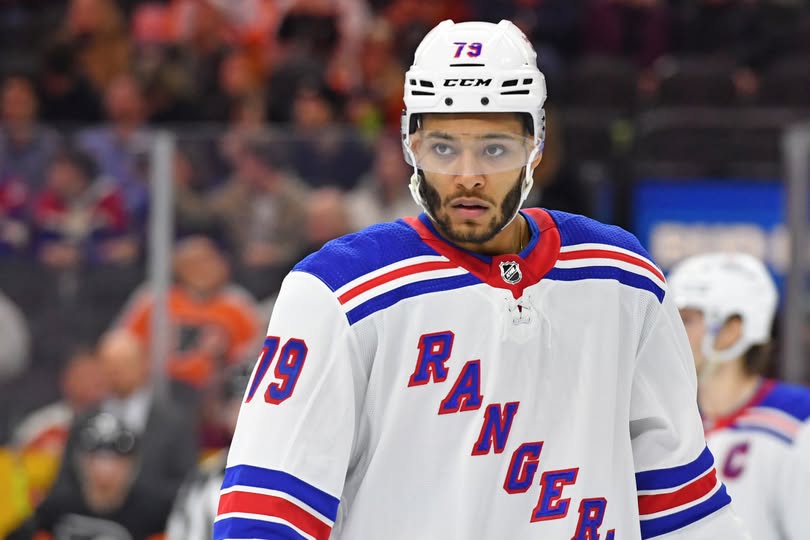The escalating contract dispute between the New York Rangers and their talented young defenseman, K’Andre Miller, has reportedly reached a critical impasse, culminating in a situation where a trade is now being viewed as the “only viable option.” This stark assessment, accompanied by the lament, “It shouldn’t have come to this,” speaks volumes about the frustration and disappointment on both sides of a negotiation that appears to have veered off course, pushing a promising long-term relationship to the brink of an acrimonious split.
For the New York Rangers, a franchise perennially in contention and navigating the tightrope of the NHL’s salary cap, securing their foundational young talent is paramount. K’Andre Miller, a first-round pick from the 2018 NHL Entry Draft, has rapidly developed into an integral piece of their defensive core. His blend of size, skating ability, offensive upside, and defensive responsibility makes him a rare commodity in today’s NHL. He’s a player who can log significant minutes, contribute on both special teams, and provide the physical presence needed to succeed in the high-stakes environment of playoff hockey. Losing such a player, especially at this stage of his career, would be a significant blow to the team’s immediate competitiveness and long-term vision.
Miller’s journey with the Rangers has been one of steady progression. After a standout collegiate career at the University of Wisconsin, he seamlessly transitioned to the professional ranks, quickly earning a spot in the Rangers’ lineup. He displayed flashes of brilliance from his rookie season, showcasing his elite skating ability and his knack for joining the rush. Over subsequent seasons, his defensive game matured, becoming more reliable in his own zone, improving his gap control, and demonstrating a willingness to play a physical brand of hockey. By the time contract negotiations for his next deal (likely his second NHL contract after his entry-level deal, or potentially his third if this impasse occurred further into his career, which seems unlikely given the “young star” context) became prominent, he had firmly established himself as a top-four defenseman with the potential for even greater heights.
His contributions were not just statistical; they were foundational. Miller played a crucial role in the Rangers’ recent successes, including deep playoff runs. His ability to shut down opposing top lines, retrieve pucks effectively, and initiate breakouts with his skating made him indispensable to the team’s fast-paced, aggressive style of play. He was seen as a key component for the present and future, a player around whom the defensive corps would be built for years to come.
The sentiment “It shouldn’t have come to this” suggests a breakdown in communication, a fundamental disagreement on value, or perhaps an inability to bridge a relatively small gap that has since widened into an unmanageable chasm. Several common factors can lead to such a critical standoff:
- Disagreement on Market Value: The most common reason for contract disputes. Miller’s camp likely believes his performance warrants a higher annual average salary (AAV) and potentially a longer term than what the Rangers are willing to offer. They might point to comparable players around the league who have recently signed lucrative deals, especially those with similar age, production, and potential. The Rangers, conversely, might be offering a deal based on their internal valuation, their salary cap constraints, and perhaps a more conservative projection of his future impact.
- Salary Cap Constraints: The NHL’s salary cap, while rising, is still a significant constraint for contending teams. The Rangers, like many successful franchises, are constantly juggling multiple high-value contracts and trying to project future cap space. Signing Miller to a long-term, high-value deal could restrict their ability to re-sign other key players, acquire new talent, or maintain flexibility. This forces tough decisions and limits offer flexibility.
- Term of the Contract: Players often seek long-term security (6-8 years) to maximize earnings and stability. Teams might prefer shorter “bridge” deals (2-4 years) to allow for further evaluation, especially with younger players, or to maintain cap flexibility. A disagreement on the length of the the contract can be as impactful as the AAV.
- Performance vs. Potential: The player’s camp emphasizes potential and projected growth. The team might focus more on established production and a more conservative view of future development, especially if there are any lingering questions about consistency or injury history (though Miller’s appears relatively clean).
- Agent Strategy: Player agents play a crucial role. Some are known for taking hardline stances to maximize their clients’ earnings, sometimes pushing negotiations to the brink. While their job is to advocate for the player, sometimes this aggressive approach can lead to impasses.
- Team Strategy: The Rangers, too, might have adopted a firm stance, believing their initial offers were fair and that overpaying one player could have detrimental effects on team building. This could be part of a broader organizational philosophy on contract management.
- Emotional Factors: Protracted, public negotiations can become emotionally charged, leading to entrenched positions where neither side wants to concede. The phrase “It shouldn’t have come to this” suggests a sense of regret and perhaps a belief that earlier compromises could have averted the current crisis.
When a contract standoff reaches this point, a trade becomes the logical, albeit painful, next step for several reasons:
- Avoid Losing Him for Nothing: If Miller and the Rangers cannot agree on a contract, the team risks losing him as an unrestricted free agent (UFA) in the future for no compensation (assuming he eventually reaches UFA status without a deal). Trading him ensures they at least get assets in return.
- Asset Management: A player of Miller’s caliber is a valuable asset. If he won’t be part of the long-term plan due to contract impossibility, the team must maximize the return on that asset. Delaying a trade only risks devaluing the asset if his performance dips or injury concerns arise.
- Team Chemistry and Focus: A lingering, public contract dispute can be a distraction for both the player and the team. It can create an uncomfortable atmosphere in the locker room and detract from the team’s focus on winning. Resolving the situation, even through a trade, brings clarity.
- Salary Cap Relief: Trading a high-priced player, or one who would command a high price, frees up valuable salary cap space that can be reallocated to other roster needs or to sign other players.
- Meeting Player’s Demands (Indirectly): While the team might not meet the player’s demands directly, a trade could send Miller to a team willing and able to offer the contract he seeks, thus satisfying his long-term financial goals.
Any team acquiring K’Andre Miller would be looking for a long-term solution on their blue line. Potential suitors would likely be:
- Teams with Cap Space: Franchises with significant cap flexibility who can afford to sign Miller to the deal he desires.
- Contenders with a Defensive Need: Teams looking to bolster their defensive corps for a playoff push or to solidify their top four.
- Rebuilding Teams with Assets: Teams in a rebuild who have draft capital or promising young players they’re willing to move for a proven talent like Miller.
The Rangers, in turn, would be seeking a substantial return, likely including a combination of:
- High Draft Picks: First-round or early second-round picks would be a priority to replenish their prospect pool.
- Prospects: Young, high-upside players (especially forwards or other defensemen) who fit into the Rangers’ future plans.
- Roster Players: Players who can provide immediate help in areas of need, perhaps on cheaper contracts.
The phrase “It shouldn’t have come to this” speaks to a collective sense of failure. For the Rangers, it’s the failure to lock up a homegrown talent who was developing into a star. For Miller’s camp, it’s the failure to secure a fair deal with the team that drafted him and where he has spent his entire NHL career. This implies that there was genuine mutual interest in a long-term partnership that, for reasons perhaps beyond simple monetary figures, ultimately couldn’t be realized. It’s a sad reality of professional sports that sometimes, even with the best intentions, the business side can overshadow the human and athletic desires, leading to an unavoidable, yet regrettable, parting of ways. The Rangers and K’Andre Miller now face the challenge of moving forward from a potentially avoidable breaking point.
Beta feature


